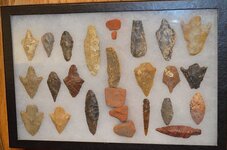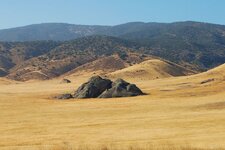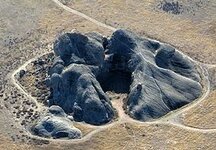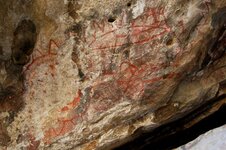BosnMate
Gold Member
- Sep 10, 2010
- 6,916
- 8,441
- Detector(s) used
- Whites MXT, Whites DFX, Whites 6000 Di Pro
- Primary Interest:
- Other
 The ten points on the left are from my property in Atascadero, California, the thread about the bowl tells about it, and the points would be Salinian. Those points that look like arrowheads are to large, and are more likely atl atl points. The ten on the right are Chumash and for the most part come from the mound I mentioned in a different post, the one out by Morrow Bay where my Uncle taught me what to look for when hunting arrow heads. The top right hand point looks like it's broken, but it has been worked into that rounded point, and I'm wondering if perhaps it was a knife. The bottom red one was found in the driveway of our house in San Luis Obispo. It was in the drip line, and no doubt came in with the driveway rock. It was broken when found, the car had been driving on it, probably for years, and I glued it together using model airplane glue, which you can see in the photo. Down the middle is paint pigment, both red and yellow. In eastern San Luis Obispo county is the Carrizo Plains, and out on that plain there is a location called Painted Rock. There is also a dry lake bed called "Soda Lake." During the war military aircraft would shoot up Soda Lake for practice. Our extended family went out there for a picnic one summer day after the war, (WWII) and us kids were having a ball finding .50 cal. brass in the sage brush. There was an old rusted out dump where the adults were looking for bottles or what ever, and one of the men killed a rattlesnake, so us kids were gathered up and we went up to Painted Rock. I didn't take any pictures at the time, but there are plenty on the internet. I'll grab a couple of them.
The ten points on the left are from my property in Atascadero, California, the thread about the bowl tells about it, and the points would be Salinian. Those points that look like arrowheads are to large, and are more likely atl atl points. The ten on the right are Chumash and for the most part come from the mound I mentioned in a different post, the one out by Morrow Bay where my Uncle taught me what to look for when hunting arrow heads. The top right hand point looks like it's broken, but it has been worked into that rounded point, and I'm wondering if perhaps it was a knife. The bottom red one was found in the driveway of our house in San Luis Obispo. It was in the drip line, and no doubt came in with the driveway rock. It was broken when found, the car had been driving on it, probably for years, and I glued it together using model airplane glue, which you can see in the photo. Down the middle is paint pigment, both red and yellow. In eastern San Luis Obispo county is the Carrizo Plains, and out on that plain there is a location called Painted Rock. There is also a dry lake bed called "Soda Lake." During the war military aircraft would shoot up Soda Lake for practice. Our extended family went out there for a picnic one summer day after the war, (WWII) and us kids were having a ball finding .50 cal. brass in the sage brush. There was an old rusted out dump where the adults were looking for bottles or what ever, and one of the men killed a rattlesnake, so us kids were gathered up and we went up to Painted Rock. I didn't take any pictures at the time, but there are plenty on the internet. I'll grab a couple of them.

 You can see from the first picture that the land has been farmed right up to the rock, and in those days the rock was on private property. We stopped at the farm house and were given permission to go up to the rock, and sadly, by the late 1940's the paintings had already been vandalized. I believe the state owns the rock now, and there is some semblance of protection. Back to the paint pigment, the land had been farmed and everyone in our group was on the plowed ground looking for arrowheads or what ever. I found this out of place mineral, totally different from everything else around there, and the adults all agreed that it's paint pigment, and now so do I. The Indians ground it up and mixed it with hide glue to make paint. If anyone is interested in more information about Painted Rock, Google Painted Rock Carrizo Plain, and there is lots of information.
You can see from the first picture that the land has been farmed right up to the rock, and in those days the rock was on private property. We stopped at the farm house and were given permission to go up to the rock, and sadly, by the late 1940's the paintings had already been vandalized. I believe the state owns the rock now, and there is some semblance of protection. Back to the paint pigment, the land had been farmed and everyone in our group was on the plowed ground looking for arrowheads or what ever. I found this out of place mineral, totally different from everything else around there, and the adults all agreed that it's paint pigment, and now so do I. The Indians ground it up and mixed it with hide glue to make paint. If anyone is interested in more information about Painted Rock, Google Painted Rock Carrizo Plain, and there is lots of information.Amazon Forum Fav 👍
Last edited:
Upvote
1



 Other than the potential for arrowheads, the site of those rocks looks like a really good site to metal detect.
Other than the potential for arrowheads, the site of those rocks looks like a really good site to metal detect.
